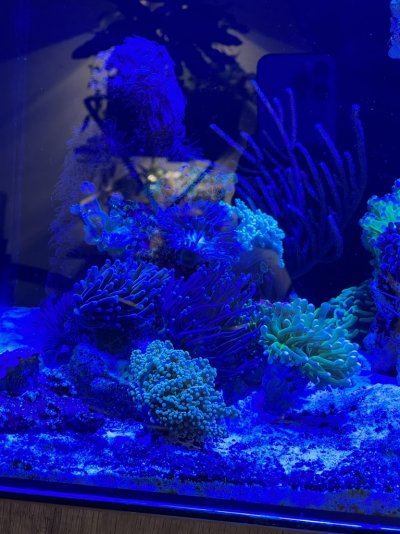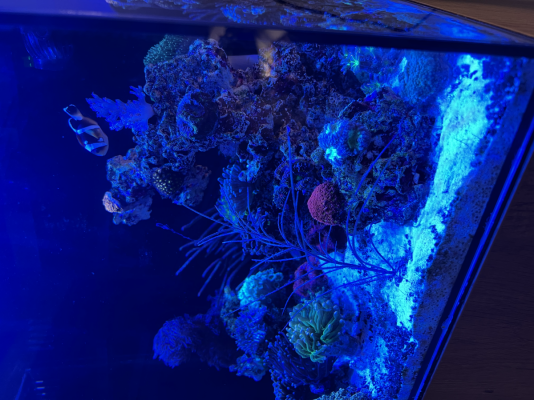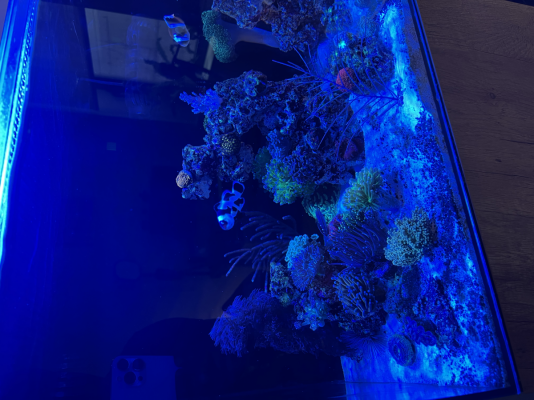Timeline on how Dino started and how I dealt with it(incl. theory)
November 201
- New Tank setup (20g) is complete.
- Tank parameters were at normal levels
December 2021
January 2022
February 2022
The method that killed BHA and fixed the Dino issue "slightly."
March 2022
What I learned:
Bacterias are your number 1 cleanup crew. Keep them happy and they'll keep you & your tank happy.
PS. I forgot to take pictures when my tank was infested with BHA & Dino



November 201
- New Tank setup (20g) is complete.
- Tank parameters were at normal levels
- PH: 8.2
- Calcium: 450
- Mag: 1500
- NO3: 5
- Phos: 0.08
- AlK: 9
- Salinity:1.027
- Temp: 79
December 2021
- After a month of cycling, I started adding corals and four new fishes (clowns and cardinals) in such a short period.
- A noticeable amount of diatoms started appearing. Expected for a one-month-old tank.
- My Phosphates went up to 1.32!!
- So I panicked and added phosguard, which significantly lowered the amount of phosphate + silicates.
- After a week, there were no signs of diatoms in the rocks or sand bed.
- I left the phosguard in the tank and assumed nothing could go wrong, and boy, was I wrong.
January 2022
- A large amount of BHA appeared on rocks and sand.
- My Phosphates level went to 0/undectable levels.
- Dino (a large number of bubbles started to appear everywhere). I thought this was part of the ugly phase. I was wrong. The Dinos(snotty bubbles) only appeared during the daytime/or when lights were on.
- Nitrates levels went to 0/undectable levels. BHA and Dino got worse and were suffocating corals.
- Based on heavy research(from blogs, etc.), the consensus is that undetectable Phosphate and Nitrate levels may cause Dino. I did the following (which didn't work)…
- Dosed both Neonitro and Neophos
- Dosed Dr.Tims waste away (Made no changes in water parameters or Dinos)
- Reduced light intensity and period
- Did a 3-day blackout. Dino's issue came right back after turning on the lights.
- Increased temperature up to 83F degrees.
- Added a UV sterilizer. This only made the water clear and reduce the amount of BHA. Dino were still there.
- Added cleanup crew (snails mostly
- Adding phytoplankton and copepods.
- Vacuum sandbed and Weekly 60% water changes (this only made the issue worse!!).
February 2022
The method that killed BHA and fixed the Dino issue "slightly."
- Treated the tank with DinoX & Blue Life Reef Flux .
- After four days, the BHA and Dino issue subsided dramatically. I'm not entirely sure which method(DinoX or Blue Life Reef Flux) made them gone. Since DinoX is an algaecide, it was expected that BHA would die.
- My nitrates levels shot up to 20 nitrates (due to the die-off from the BHA and Dino)
- Unfortunately, high level nutrients bleached my SPS frag and killed my plate coral and elegance corals.
- Per instructions, I did a 50% water change.
- Two weeks by and I decided to change my sanded from the dark Caribbean sea sand to the fine white sand.
- After two days, noticeable brown spots started appearing. I thought these were diatoms.
- After four days, I noticed bubbles appearing on the sand. You guessed it, DINOs.
March 2022
- I thought of treating the tank with DINOX & FluxRX but did not want to stress my corals. They've gone through a lot already. There has to be a safer, natural way.
- Based on research, you can't eliminate Dinos from your tank. You need something else to complete it. I thought maybe there weren't enough bacteria in the tank…so,
- I dosed prodibio digest.
- After adding Prodibio, the brown spots and bubbles resided dramatically after two days. However, my nutrient levels went down from NO3: 15, Phos: 0.30 to NO3: 3, Phos: 0.04. This tells me that the bacteria are doing their job.
- I noticed some purple spots, and it appeared to be cyano. Due to the low nutrient levels, I panicked and dosed with some Neonitro & Neophos.
- After dosing Neonitro & Neophos (bringing my tank back up to nutrient mid-levels), those purple spots were gone the next day.
- I haven't done any water changes for 2 weeks
What I learned:
- Dinoflagellates are always on your tank.
- Low/undetectable nutrients = starving bacteria = less bacteria to compete = Dinos (opportunists)
- Bacteria do not like (large) water changes and disturbance in the sandbed(heavy vacuuming). Stability is key.
- Dino can thrive in low light level so, reducing light intensity or period won't do much.
- High nutrients either means your filtration isn't enough, you're feeding too much or you don't have enough of these bacterias to help.
- Not a popular opinion, but Dino's thrive on high nutrients when there aren't enough bacteria to compete. If Dinos were to appear again, I would…
- Turn off UV for a day.
- Supplement with Prodibio digest so bacteria competes over Dino. Not all bacteria (in bottles) are the same. As mentioned above, Dr.Tims waste away didn't work.
- Supplementing Prodibio digest would significantly reduce nutrients, hence, I'd dose Neonitro & Neophos. Keep your nitrate around 5ppm or more and phosphate around 0.1.
- Skip water changes.
Bacterias are your number 1 cleanup crew. Keep them happy and they'll keep you & your tank happy.
PS. I forgot to take pictures when my tank was infested with BHA & Dino
















